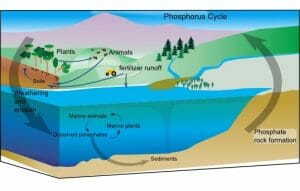Phosphorus Cycle Definition
The phosphorus cycle is the process by which phosphorus moves through the lithosphere, hydrosphere, and biosphere. Phosphorus is essential for plant and animal growth, as well as the health of microbes inhabiting the soil, but is gradually depleted from the soil over time. The main biological function of phosphorus is that it is required for the formation of nucleotides, which comprise DNA and RNA molecules. Specifically, the DNA double helix is linked by a phosphate ester bond. Calcium phosphate is also the primary component of mammalian bones and teeth, insect exoskeletons, phospholipid membranes of cells, and is used in a variety of other biological functions. The phosphorus cycle is an extremely slow process, as various weather conditions (e.g., rain and erosion) help to wash the phosphorus found in rocks into the soil. In the soil, the organic matter (e.g., plants and fungi) absorb the phosphorus to be used for various biological processes.
Phosphorus Cycle Steps
The phosphorus cycle is a slow process, which involves five key steps, as shown in the diagram below and described as follows:
Weathering
Since the main source of phosphorus is found in rocks, the first step of the phosphorus cycle involves the extraction of phosphorus from the rocks by weathering. Weather events, such as rain and other sources of erosion, result in phosphorus being washed into the soil.
Absorption by Plants and Animals
Once in the soil, plants, fungi, and microorganisms are able to absorb phosphorus and grow. In addition, phosphorus can also be washed into the local water systems. Plants can also directly absorb phosphorus from the water and grow. In addition to plants, animals also obtain phosphorus from drinking water and eating plants.
Return to the Environment via Decomposition
When plants and animals die, decomposition results in the return of phosphorus back to the environment via the water or soil. Plants and animals in these environments can then use this phosphorus, and step 2 of the cycle is repeated.
Human Impact on the Phosphorus Cycle
Humans have had a significant impact on the phosphorus cycle due to a variety of human activities, such as the use of fertilizer, the distribution of food products, and artificial eutrophication. Fertilizers containing phosphorus add to the phosphorus levels in the soil and are particularly detrimental when such products are washed into local aquatic ecosystems. When phosphorus is added to waters at a rate typically achieved by natural processes, it is referred to as natural eutrophication. A natural supply of phosphorus over time provides nutrients to the water and serves to increase the productivity of that particular ecosystem. However, when foods are shipped from farms to cities, the substantial levels of Phosphorus that is drained into the water systems is called artificial or anthropogenic eutrophication. When levels of phosphorus are too high, the overabundance of plant nutrients serves to drive the excessive growth of algae. However, these algae die or form algae blooms, which are toxic to the plants and animals in the ecosystem. Thus, human activities serve to harm aquatic ecosystems, whenever excess amounts of phosphorus are leached into the water.
Quiz
1. The most abundant source of phosphorus on the planet is:
A. Soil
B. Water
C. Rocks formed from the Earth’s crust
D. Algae blooms
2. Which of the following is NOT a critical function of Phosphorus:
A. Nucleotide formation
B. Cell membranes
C. Plant and animal growth
D. All of the above
E. None of the above
F. A and C only
3. Excess phosphorus caused by fertilizers leaching into water systems is dangerous because:
A. It causes algae blooms which are toxic to plants in water ecosystems
B. It causes algae blooms which are toxic to animals in water ecosystems
C. It causes algae blooms which are toxic to the animals which drink the affected water
D. All of the above
References
- Accoroni S, Totti C, Razza E, Congestri R, Campanelli A, Marini M, and Ellwood NTW. (2017). Phosphatase activities of a microepiphytic community during a bloom of Ostreopsis cf. ovata in the northern Adriatic Sea. Water Research.120:272-279. doi: 10.1016/j.watres.2017.05.004. [Epub ahead of print].
- Emsley, J. (1980). The Phosphorus Cycle. The Natural Environment and the Biogeochemical Cycles: Chapter in The Handbook of Environmental Chemistry.: pp.147-167.
- Forum on Microbial Threats; Board on Global Health; Institute of Medicine. (2014). The Influence of Global Environmental Change on Infectious Disease Dynamics: Workshop Summary. National Academies Press (US), Washington (DC).
- Lladó S, López-Mondéjar R, and Baldrian P. (2017). Forest Soil Bacteria: Diversity, Involvement in Ecosystem Processes, and Response to Global Change. Microbiol Mol Biol Rev. 81(2). pii: e00063-16. doi: 10.1128/MMBR.00063-16. Print 2017 June.
- Mao R, Li SY, Zhang XH, Wang XW, and Song CC. (2017). Effect of long-term phosphorus addition on the quantity and quality of dissolved organic carbon in a freshwater wetland of Northeast China. Sci Total Environ. 586:1032-1037.
- Mu D, Ruan R, Addy M, Mack S, Chen P, Zhou Y. (2017). Life cycle assessment and nutrient analysis of various processing pathways in algal biofuel production. Bioresour Technol. 230:33-42.
Phosphorus Cycle
No comments:
Post a Comment